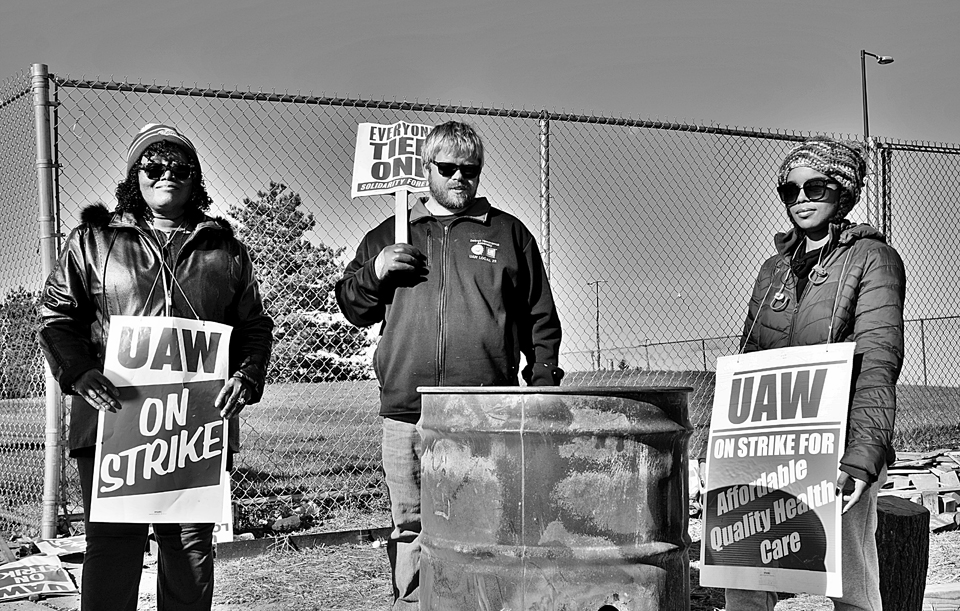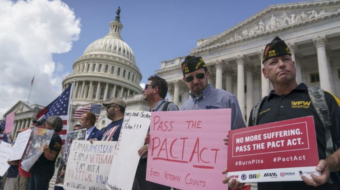
This article won a second place award in the Best News Story category at the 2020 Labor Media Awards, presented by the International Labor Communications Association.
DETROIT—To an outsider’s eyes, the famed Motor City is scarred. The air hangs heavy throughout its waterfront skyline, facing the southernmost point of Canada.
The melodramatic clash between Art Deco skyscrapers, aiming to embody the “world of tomorrow,” and the neo-Gothic spires overlooking the Detroit River highlights the many cracked and crumbling buildings spread throughout its neighborhoods. Sirens and car horns rise and fall in the dim background, a sound akin to the crooning of a muted, dejected saxophone.
Watching residents coming and going, starting or ending work, waiting for the next trolley or bus, you begin to notice a curious quality within their eyes as your gaze meets theirs: a quiet, yet firm determination.

It is the same determination found in the 49,000 faces of striking General Motors workers, all members of the United Auto Workers union, all fighting to gain back what was lost during and after the Great Recession of 2008.
For over 30 days, their cracked and calloused hands—a part of Detroit represented in flesh—have been wrapped around picket signs’ wooden posts; their feet marching back and forth in front of the now idled auto manufacturing plants.
The UAW’s strike against GM has now become the longest strike since the 67-day nationwide strike of 1970.
GM, meanwhile, continues to increase its profits, a record of over $11 billion in 2017, and triple that amount over three years. For GM executives and CEO Mary Parra, those profits mean more cash and stock options for their coffers, while workers are left with scraps. Better wages, affordable quality healthcare, and job security are the main issues leading up to the work stoppage.
Yet the simple fact UAW members stood together and beside GM when the company needed them goes unheard inside the corporate boardroom.
Then, the hour of a tentative agreement came at last. It was announced Oct. 16. But striking workers didn’t go back into their shops. No, they’d stay on the picket lines until the new proposed agreement was either approved or rejected.
As the sun crept over the smokestack-filled horizon, Friday, Oct. 18, I drove toward the strike line outside the Detroit-Hamtramck assembly plant. Roughly 25 UAW members were firmly planted outside the facility’s two main gates. The smell of charred wood, burn barrel smoke, and truck diesel walloped my senses as I walked onto the line—introducing myself as I kept pace with strikers.
To my left, or right, depending on where I was in the picket line rotation, a blue tarp awning protected picket signs, food, coffee, and clipboards from the elements. It wasn’t as cold as some other days and nights on the line, but the occasional breeze did chill your bones.
I met James Draft during my first roundabout on the line. He’s been a GM employee and UAW member for over 40 years. A Michigan native, Draft’s mother worked at the old GM Clark Street plant, while his father did other things, mostly ironworking.
“How’d you come to work for GM?” I asked, a truck horn blaring right as I spoke. Draft signaled for me to repeat the question, so I did.
“Well, I got out of high school, and my dad said go put in an application with Cadillac, so I did, and next thing I knew I was working the line,” said Draft. “It was a family friend who got me into GM and the union, and ever since that first day, I knew it’d be hard to quit and find such a good job with all our union benefits.”
We chatted for a bit before I asked him about his reasons for walking off the job. He paused, took a breath and said: “Pay for these younger people to get them up to our pay scale.
“They shouldn’t be out here for eight years and not making full pay…it’s kind of ridiculous. These younger part-time workers will come here, go sit in a room for two hours, then get sent home without pay because there’s no work for them to do…. doesn’t seem right to me. I know when I was hired in after 90 days I was up to scale, that’s how it should it be.”
As we continued our march around the front gate, Draft mentioned he’d seen bits and pieces of the tentative agreement highlights. “I’ve liked what I’ve seen so far,” he said. “But, I’m curious as to what the low lights are—you know the devil’s always in the detail, but it looks alright to me.”
“How’ve you been feeling about the strike overall?” I asked. “Staying out till the end of voting? What it means in the long run?”
“You know, we used to have over 100,000 members at GM, now we’re down to what, 48,000? Our jobs keep getting shipped overseas or cut for profit’s sake, and I’m tired of losing,” Draft said.
“It seems like we’ve been losing a lot lately, and it’s time we change that. I’d rather stay out on strike than go back in. Let’s keep putting pressure on GM and get these younger folks paid so they can take care of their families, and maybe buy a union-made car too. So, until I’m told to go back to work, I’m happy to stay right here.”
I met Isaiah Dukes, 22, right after stepping off the line, camera in tow, the shutter clicking and clacking as it captured the day’s strike activity.

Dukes was intently staring down at his cellphone as I caught his stride. He looked up, said hello, and asked me to give him a minute. “I’m reading the TAs (tentative agreements) now.”
Like many Michigan natives, Dukes entered the auto industry and UAW straight out of high school. “Next year in April, I’ll have four years at GM,” said Dukes.
His father, a UAW member too, works over at the Chrysler plant, and as Dukes said, “He hit me with a GM application just as I was about to graduate…. It’s a great job, but it’s brutal work.”
As a second-tier GM worker, Duke sees the good and bad of the proposed agreement. The issue of pay equity and full scale pay for second-tier workers was a big issue he didn’t think got fixed completely.
“This 52-weeks worked issue is still kind of in there,” he said. “For you to get a raise, you have to work a full 52-week period, not calendar year, from your start date, and you won’t get a pay raise if you get laid off for any period during those 52 weeks.
“When you first start, you get laid off often; you’re low seniority, there’s not enough work. I know I was off for five months a while ago. Then they’ll bring you back and you stick around long enough to get seniority right before the company starts thinking about making the next round of cuts.” Dukes explains that the 52-week requirement for second-tier workers is still in the TA, but “after reading everything else, it’s my only small gripe.”
On the flip side, he explained, the GM-UAW worker profit-sharing cap was removed, health insurance stayed intact, and the cap on raises was increased.
“I feel like a lot of my peers; the ones I’ve talked to lately really wanted the pension, but I don’t know if that’ll ever come back.”
“What were your reasons for striking?” I asked after another round of solidarity car horns flew by.
“I feel like you have to come out here regardless of the issues; you have to show your support, to show you won’t let upper management and corporate treat you like mindless robots,” Dukes said. “We are all people at the end of the day, we have homes and families, yet, upper management doesn’t see that. All they see are numbers… ‘bodies…’ that’s what they say: ‘Oh, we need a body on line three,’ not ‘Oh, we need to replace Isaiah Dukes on the line’ when I clock out.
“We came out here (on strike) out of necessity to show that we’re going to fight for our rights and better treatment. And I plan on being here till the bitter end. Until they tell me to go back in.”
Two hours on the line passed quickly. At 10:15 a.m., a silver Chevy SUV, the bumper emblazoned with a UAW sticker, pulled up with fresh coffee and union updates.

Joe Ryan, a UAW union representative trainee from the Hamtramck plant, stepped out wearing a red UAW Local 22 hoodie and UAW ball cap. He called the strikers together and talked through what would be happening at every union hall over the coming days.
Twenty minutes later, Ryan walked over to me, shook my hand as I introduced myself, and asked me a direct question: “Do you believe in organized labor?”
I won’t lie and say it didn’t catch me off guard because it certainly did. I looked right back at him and said, “You’re damn right I believe in organized labor.”
He chuckled, saying, “Good, then we can talk.”
I don’t blame him or any other union member for being leery of outsiders, especially if they’re press. Throughout the American labor movement’s history, the mainstream press has not done right by its “honest” (corporate) coverage of working people—choosing instead to parade half-truths, or even outright lies, of labor’s constant struggles for progress and workers’ rights.
“What’s this strike mean to you?” I asked Ryan.
“We’ve (UAW) laid the foundation if you will, we’ve started a revolution because now everybody is jumping on the strike wagon,” he said. “I feel the UAW with this strike, we showed we were willing to do whatever it takes to make sure everyone got a piece of the pie…. We weren’t trying to break GM, we just wanted to get our fair share.
“Back in 2007, we minimized the contract and allowed certain things to happen. We just want back what we lost…but it’s because of GM’s corporate greed, because of their bottom-line focus, that we (GM workers) stuck together, fought together, went out on strike—uniting temporary workers with seniority workers, and, more importantly, it brought the Big Three workers (GM, Ford, Chrysler) back together.”
Ryan said this strike allowed the younger UAW generation to understand the struggle, to understand why all workers need a union, and why fighting for a good contract and ensuring workers’ rights are not violated is so important.
“You know, some people died, gave their lives for the labor movement. We’re not giving up our lives, just some comforts and times, but the bottom line is we know we can’t get it all, but we will certainly get back what we rightly deserve.”

When asked about staying out on strike after a proposed agreement was reached, Ryan clearly said: “Absolutely, it was a good idea because we are in it to the end. It just makes sense. Of course, we’re cold, a lot of us are ready to go to work. However, the fight’s not finished yet.”
“What does this mean for GM in the long run?” I asked, before heading out to the next picket line further into Detroit.
“Well, first, I’m glad the UAW chose GM (to strike) first instead of Ford or Chrysler. We may be the smallest, but we have the biggest impact,” Ryan said. “And second, GM opened up a can of worms by pushing us too far. They reunited all of us, unintentionally, and if they (Ford, Chrysler) go out on strike, we all go out on strike… We’re an unstoppable force now.”










